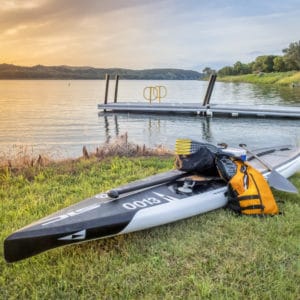Choosing your paddle length is as easy as choosing a pair of shoes: just try some pairs and pick the one that suits you best. Easy peasy, right?
Not so fast… there’s a bit more to it than that. In fact, this post is around 2000 words long.
I know that’s scary for something that seems so easy, but don’t leave this page just yet.
I’m sure you’ll be glad you read all this info when you glide on the water like a majestic dolphin instead of sweating and puffing like an 80-year-old.
Additionally, you’ll make it look so easy that everyone else will think you’ve been kayaking for years. But don’t tell them your secret−it’s your time to shine.
What paddle length should I get
The length of your paddle will depend on your torso height, kayak width, seat height, and stroke angle. Read on to find the perfect paddle size so you can glide effortlessly on the water.
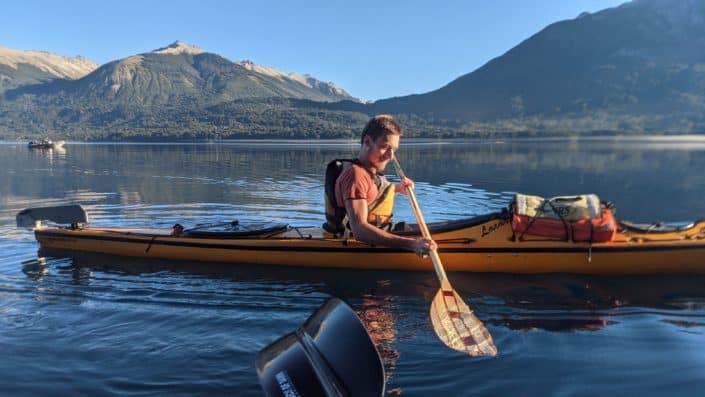
Torso Height
The best way to find the perfect length for your paddle is to sit straight (like you would in a kayak) and to measure the distance between your butt and your eyes.
You can use your total height (for instance, 5ft9) if you want to save time, but the results won’t be as accurate as some people have longer legs than others.
Kayak Dimensions
Kayak Width
You should know that kayaks have different widths according to their use. This means that touring kayaks will usually be narrower than surfing kayaks, while whitewater kayaks will be the wider of the three.
For instance, if you need a 240cm long paddle for touring, you’d need a 220 long paddle for surfing, and a 200 long one for whitewater kayaking.
If you know how wide your kayak is, you can use the Kayak Paddle Sizing Chart below to see the paddle length that will most likely suit you, according to your height.
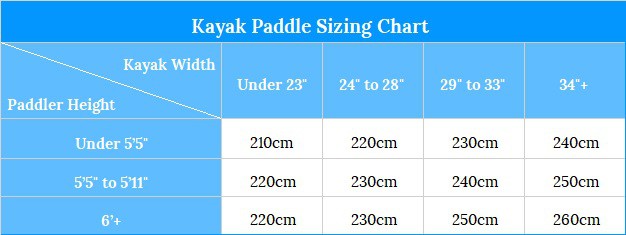
Seat Height
Using the chart above, you can then add 10 more centimeters to your paddle length if you plan on using a sit-on-top kayak. Then, add another 10 centimeters if you plan to use a fishing chair on top of it.
But of course, if you’re using a sit-in kayak then the above Sizing Chart is all you need.
Stroke Angle
You should know that the length of your paddle is also affected by your stroke angle, namely, if you use a low-angle blade or a high-angle blade.
We’ll get into the specifics of these later, but for now, just know that you need a slightly longer paddle if you have a low-angle blade.
Adjustable Length
There are some cases in which an adjustable paddle length might come in handy, such as:
- You want to use one single paddle for several activities and in different kayaks
- You plan to share your paddle with your partner or someone else
- You want to change your seat height regularly, for instance when you are kayak fishing
If any of the above seems like something you’d need, then getting a telescoping ferrule system could be worth it. This fancy name simply means that you can add an extra 15cm to the paddle’s length effortlessly.
Watch the video below to see how a telescoping paddle works in real life.
Between two sizes
If you’re between two sizes, you should go with the shorter one. Unless you have a very small torso, in which case you should opt for the longer one. Easy, right?
Real-life test
You should always test several paddles before settling on one. Many retailers offer on-water demos that you should take advantage of. Be sure to have proper technique when you test your paddle, as you might end up with a terrible one if you don’t.
Here’s how to know if your paddle has the correct length while kayaking:
- Perfect length paddle: While you paddle, the blade is fully immersed and the shaft isn’t (or at least not too much)
- Short paddle: While you paddle, the blade is only half immersed
- Long paddle: While you paddle, a big part of the shack is immersed in the water
Finally, to choose a paddle to try before you enter your kayak, simply do this: straighten your arms along the shoulder line, bend your elbows at 90° and hold the paddle. If your hands fall at roughly ⅔ of the paddle, you’re good to try it.
What blade shape to choose
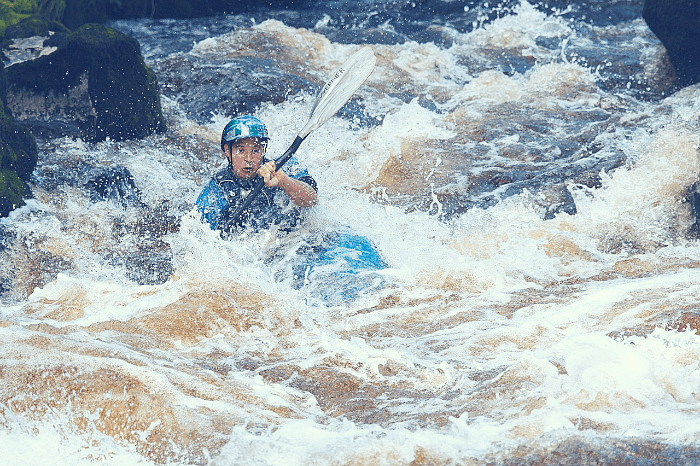
The blade shape will mostly be determined by your kayaking style. If you’re kayaking on long distances at a relaxed pace, or if you’re racing or kayaking down rapids, you won’t need the same blade shape.
High-angle vs low-angle blade
Choosing between a high-angle (wide and short) or low-angle (long and thin) blade is very easy: the former is great for speed and competition as well as whitewater kayaking and kayak surfing, while the latter is better for relaxed, recreational or touring kayaking.
Additionally, if you’re often stopping and starting again, or if you need a lot of control like for kayak fishing, then you should go with a high-angle blade.
Simply put, a high-angle blade gives you more acceleration and power, whereas a low-angle blade is less tiring. This also means that high-angle blades are better if you’re carrying a lot of gear.
Feathered or matched blades
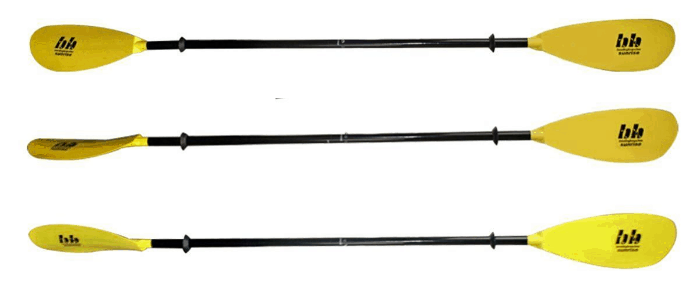
Feathered blades are blades that are not parallel to each other, but rather at an angle (generally 30° or 45°). This makes the blades more efficient as they cut through the wind, but it also makes them trickier for beginners.
A good thing to know is that feathered blades are not recommended if you have joint problems or pain in your wrists, because it puts extra strain on your control hand.
That said, many paddles allow you to make them feathered or unfeathered thanks to the center ferrule (the center joint of a two-piece or four-piece paddle). The only exception to the rule is one-piece paddles, which are either feathered or matched, but can’t be changed easily.
Blade Shape
There are essentially two shapes of blades: spoon blades and dihedral blades.
Spoon Blade
A spoon blade has more power but is trickier for beginners, because it will flutter if your technique is not perfect.
If you are a beginner, the only reason to choose a spoon blade would be because you are determined to perfecting your kayaking strokes and are willing to suffer in the process.
Dihedral Blade
This blade has a ridge along the center, which allows it to be more comfortable and to flutter less.
As you may have guessed, it’s perfect for beginners who want to be able to move forward effortlessly, even if their technique is far from perfect. Its only downside is that it’s not as efficient as a spoon blade, so you will go slower.
What Shaft To Choose
Shafts differ in three features: the number of pieces, the diameter, and the bending.
Straight or bent shaft
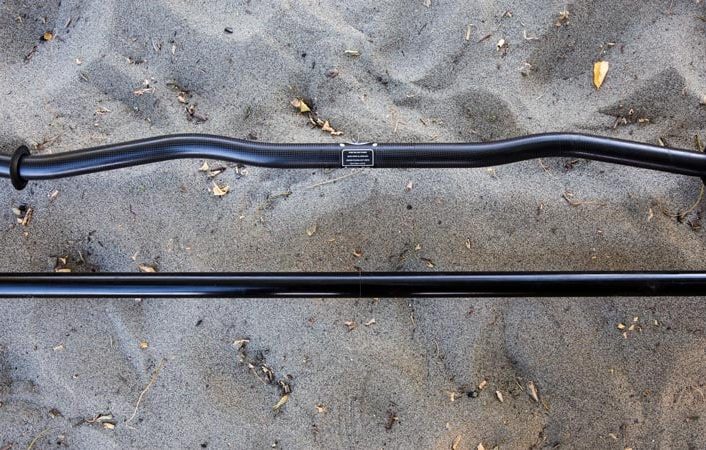
Most shafts are straight, but manufacturers also make more expensive, bent shafts. These are designed to allow your wrists to be in a neutral position while paddling, which helps prevent overuse injury for serious kayakers, and is also necessary for people with wrist problems.
One-piece, two-piece or four-piece
This is a particularly easy decision to make. A one-piece shaft will be stronger and more durable, while requiring less maintenance.
On the flip side, a two-piece shaft will be easier to transport and store, as well as allow you to make your blades feathered or matched at will. But it will also tend to be heavier, and ferrules (the joints) can wear down and suffer from the salty water and air, as well as get stuck over time.
Lastly, a four-piece shaft is even heavier and more prone to wear than a two-piece one, and is only recommended to people who really need a small paddle, to put it in a backpack, for instance.
That said, you should know that this is a minor detail which should not affect your paddle choice too much.
Small or Standard Diameter Shaft
Most kayakers will want a standard diameter shaft, but if you have smaller hands you should get a small one. You want to have a relaxed grip while kayaking, so if you can’t relax with a standard diameter shaft, then it’s simple: go for a smaller one.
kayak Paddle Materials
If you’re tired of reading already, or if you want to see with your own eyes what the heck we’re talking about, please feel free to watch the video below. You will learn a lot about the different paddle materials and their benefits.
Before diving into the different materials, you should know that weight is the most important factor to look for in a paddle.
Honestly, going from a 5-pound paddle to a 20-oz one is life-changing. You feel like you’re moving air instead of having to push hard with every stroke.
As a good analogy, imagine walking with 10-pound shoes instead of 10oz ones. Can you feel the suffering already? I bet you’d be more than willing to invest in lighter shoes, and it’s exactly the same with kayak paddles.
All in all, it comes down to how much you want to kayak. If you buy a lighter paddle, you’re guaranteed to love kayaking, whereas a heavier paddle will drag you down and may kill your love for the sport.
Plastic Paddles
These are typically the cheapest paddles, and they are also the heaviest. They are quite durable but you need to protect them from UV rays.
At the lower end of the spectrum, you generally find combinations of aluminum shacks with plastic blades.
Aluminum is also very heavy and cheap, with the added downside that it tends to get very cold or hot depending on the conditions. This means you’ll probably need to wear gloves on chilly days or in cold water.
This type of paddle is perfectly suited if you plan to go kayaking once in a blue moon, but it’s terrible if you want to go kayak touring or if you want to kayak regularly.
You guessed it: these are the paddles that are generally given to beginners.
They’re also perfect if you plan on loaning your paddle to friends, this way you’ll avoid fighting with them in case of an accident!
Carbon Fiber Paddles
This is the crème de la crème of kayak paddles.
They are the lightest and strongest of the bunch, and carbon fiber shafts are also much warmer than aluminum ones during cold weather. Obviously, these come at a price, which is sometimes as much as $250-$400.
If you are serious about kayaking or if you love kayak touring, then investing in carbon fiber paddles will definitely be worth it. You should know that this is a paddle you’ll keep during your whole life.
Fiberglass Paddles
These are between carbon fiber paddles and plastic/aluminum paddles, both in terms of weight and price.
Their benefit is that they are generally much lighter than plastic ones without being that much more expensive. It’s the one I’d recommend if you’re a beginner, as it will help you grow passionate about kayaking.
Finally, you should know that kayak paddles are available in all sorts of combinations of the above materials: plastic blade with carbon fiber shaft, carbon fiber blade with fiberglass shaft… there’s something for every budget. Again, the simple rule of thumb is that the lighter a paddle is, the better.
Special Paddles for true passionates
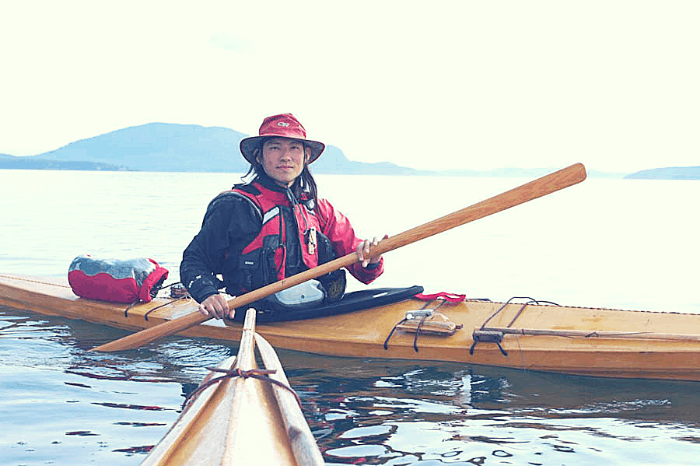
If you’re truly passionate about kayaking and you want to design your paddle yourself in the old Inuit style, a Greenland paddle may well be your dream paddle.
Price vs Performance
Let’s be honest: we all go for the cheapest option available when we start something new. However, it might be worth taking some time to think it through before buying the first paddle that comes to hand.
First of all, if you plan on going kayaking often and on long distances, then you should seriously invest in a light paddle such as carbon fiber or fiberglass ones.
Inversely, if you’ll use your kayak once in a blue moon, and if you’ll give your paddle to your loved ones and friends, then buy a cheap one.
And again, don’t forget to try before buying. It’s the only way to understand the true difference between a high-quality and low-quality kayak paddle.
Final considerations to Choose a kayak paddle
This has probably been a tedious read for something that seemed so easy−picking your first kayak paddle.
But if you only remember one thing about this whole post, let it be this: go try a high-quality, light paddle and a low-quality, plastic paddle and kayak with both for an hour or so.
Nothing speaks louder than real-life experiences, and you’ll see first-hand where your money would be going if you invested in a better kayak paddle.
And when you’re ready, check these best kayak paddles.



